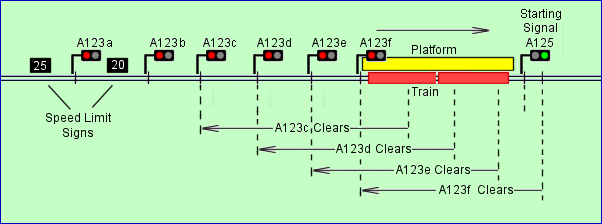Speed Control Signalling
Some locations on London Underground are
provided with speed control signalling. Trains are forced to reduce speed by red
signals which do not clear until the train speed has been reduced and confirmed.
This page describes the systems formerly and presently used on London Underground.
Contents
Speed Control Signalling - Driver's View of Speed Control Signalling - Permissive Signals
Speed Control Signalling
Many ideas for improving the movement of trains through
stations were originally imported from the USA and were adopted by London Underground from
the 1920s. One such idea was Multi Home
signals, which were introduced as early as 1908 and, in the late 1930s, speed control
signals were introduced at some locations. During the 1940s and 50s they were
installed on many lines. Most have been removed but there are still examples of them
still around today.
The principle of operation is that a signal with speed
control normally displays a red aspect until a train approaches it at the reduced speed
required. The speed is checked by a short timing-section track circuit. The
time taken by the train passing through this section must be great enough to indicate that
the reduced speed is being achieved or the signal will not clear. If the speed is
too high, the signal will remain at red until the train has stopped at the signal, then it
will clear automatically. An example of this is the approach to Archway (SB Northern
Line) where there is a 30 mi/h limit controlled by speed control signals. The
approach to Highgate was also provided with a speed control signal in the early 1960s.
Speed control at stations was introduced at a number of
locations in the late 1940s. This was really a sophisticated system of multi home
signals, as shown in the next diagram.

Fig 1: Diagram of speed control at
stations introduced at a number of locations in the late 1940s and withdrawn in the 1970s.
When there is no train in the platform, all signals will show
green and the speed limit signs will be switched off. If there is a train in the
platform, all signals are red and the two speed limit signs are lit. The full speed
overlap for the platform berth starts at signal A123a. To allow the train to draw
closer to the platform, the speed must be reduced to 25 mi/h and signal A123a will
clear. If the train speed is then reduced to 20 mi/h, signal A123b will clear.
By this time, the train in the platform should have begun to leave, allowing signals
A123c, d, e and f to clear in sequence, allowing the following train to run into the
platform at about 20 mi/h.
This system was installed on the Piccadilly Line between
Green Park and Kings Cross in 1948 and then on the District between Sloane Square and
Mansion House. The speed detectors on the Piccadilly were inductors set into dummy
sections of current rail, while those on the District used track circuits.
Speed control of home signals was installed at a number of other individual locations like
Liverpool Street (Central) and Oxford Circus (Bakerloo), where platform times were long.
The system had to be accurately designed and skilfully used
by drivers to work properly. Combined with firm control of passenger loading at the
stations involved, it worked very well. It was withdrawn when the lines were
resignalled at a time when traffic levels were falling and train services were being
reduced. There may be a good case for re-introducing it at some locations.
To the Top of this Page
Some locations on LU are still provided with a simple version
of speed controlled signalling.
 In the photos (link on the left) kindly supplied by
"Tube Troll", the sequence of operation of the four home signals approaching
Acton Town (Piccadilly Line eastbound platform) from Ealing Common is shown. In the photos (link on the left) kindly supplied by
"Tube Troll", the sequence of operation of the four home signals approaching
Acton Town (Piccadilly Line eastbound platform) from Ealing Common is shown.
Click on image for full size view and description.
The first of the four signals is speed controlled, the
remaining three clear to green as the preceding train leaves the platform. In this
example, there is no illuminated speed limit sign. Drivers learn how to approach the
signal as part of the "road training".
To the Top of this Page
Another form of speed control signal is the permissive
signal, or draw up signal. These are used at locations were there is a very short
overlap reading over a junction, at places like Earls Court and Baker Street. It is
designed to repeat the aspect of the starting signal and to force the train to reduce
speed if the signal is at red. It is unique on LU in being a three-aspect
signal. It shows green if the starter is green, red if the starter is red and yellow
when the speed of the train is confirmed as reduced to the required level.
|